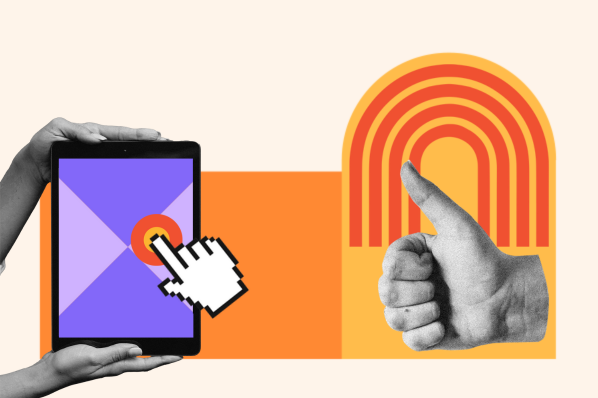You need to make your portfolio stand out among the crowd. A UX case study is a great way to do that. Let’s take a minute to define what a UX case study is and look at some examples.
Table of Contents
- What is a UX case study?
- The Benefits of UX Case Studies
- Examples of UX Case Studies
- Tips for Creating a UX Case Study
What is a UX case study?
UX portfolios are essential to showcasing UX designer skills and abilities. Every UX designer knows better designs bring better results. Sometimes, it’s easy to let the design speak for itself — after all, it is meant to engage the audience.
But, in doing that, you, as the designer, leave many things unsaid. For example, the initial problem, the need for the design in the first place, and your process for arriving at the design you created.
This is why you need to include UX case studies in your portfolio.
UX case studies tell a curated story or journey of your design. It explains the “who, what, when, where, and how” of your design. The text should be short and sweet but also walk the reader through the thinking behind the design and the outcome of it.
[Video: Creating a UX Case Study: Right and Wrong Way to Approach It]
The Benefits of UX Case Studies
There are many benefits to including UX case studies in your portfolio. Think of your UX portfolio as a well-decorated cake. The designs are the cake, and UX case studies are the icing on the cake— they will catch your audience's eye and seal the deal.
Take a look at the benefits of adding UX case studies to your portfolio.

1. Showcase skills and abilities.
A UX portfolio aims to showcase your skills and abilities and engage future clients with your work. UX case studies go beyond that, though, to highlight your skills and abilities.
UX case studies demonstrate how you apply your skills and abilities to solve user problems. It will answer the most important question a future client will have: Does this designer or company have the knowledge to understand my users’ experiences and the skills needed to improve this design?
2. Explain your thinking.
UX designs solve real-world problems. As a UX designer, it is your job to devise a solution to the problem. Although your UX design may speak for itself, a well-written UX case study helps explain each design element.
You can use a UX case study to engage your readers in your thought process through each design stage. As a result, your readers will gain a solid understanding of the “how” of your UX designs and hopefully understand how working with you or your company benefits them.
3. Highlight (solved) user issues.
A UX case study is the story of a design solution. Like any good story, you must define the characters and their problems. You should talk about the user persona and the problems they experienced before implementing the new design. This will help the reader understand user pain points and benefits.
Your UX case studies highlight the “why” of your designs and “who” benefits from the improvement. Not only that, but you will effectively demonstrate to potential clients that you understand their audience and how to solve their user experience issues.
4. Define your personality.
Whether you are an individual creating your own UX case study or a designer with a company working on compiling a portfolio, UX case studies help show off personality.
UX case studies are not just stories of your designs. Instead, they highlight your voice, tone, and brand. As a result, future clients and employers will get a feel of you, your company, and your company culture. This should help convince prospective clients that you are a good match for them and can solve all their UX design woes.
Examples of UX Case Studies
Now, let’s take a look at real-world case studies.
Spotify

Spotify’s UX case study, “How Spotify Organizes Work in Figma to Improve Collaboration,” is brightly colored and engaging. This UX case study clearly defines the user issue, the goal of the design project, and the steps Spotify took to correct it.
In this case study, Spotify demonstrates the entire design process from start to finish. As a result, readers of this study understand the problem, the thinking, and the results of the outcome.
What we like: This case study is brightly colored and full of visuals, including graphics and screenshots. The visuals and the bright colors draw the reader in to keep them engaged with the study.
Colors Over Calories

Most UX case studies include a section defining the user persona. Good UX designers research the average user to understand their experience and problems. For example, the UX case study by Colors Over Calories clearly defines the users of their app.
Not only does this UX case study include an introduction, a detailed process section, and a section describing the research, but it also includes three distinct user personas.
Each user persona consists of a user name, photo, and user goals, needs, and frustrations. This helps the reader understand the “why” for the design improvements.
What we like: User personas are essential for telling the user experience story. Color Over Calories clearly defines each category of its users and their pain points.
Routr

Oliva Throng’s UX case study for Routr is an excellent example of a case study that nails the “how.” This UX case study spends significant time explaining the problem and Oliva’s steps to determine a viable solution.
In addition, the designer incorporates screenshots, graphs, and handwritten flow maps to explain the rationale behind her thinking.
While the initial Routr app is not perfect according to the study, the conclusion section of the UX case study recognizes the need for more work but invites the reader to check out the app in its current state.
What we like: Not all UX case studies are the “end all, be all” of user experience. In the conclusion section of this case study, the designer calls out potential questions that need to be answered. The conclusion section is a great place to discuss how to proceed with a design.
Splitwise

If you are just venturing into the world of UX design and need UX designs to showcase in your portfolio, this UX case study by Chethan KVS is a great example of how to build your portfolio without contracted work.
While Splitwise did not contract Chethan to complete an app redesign, he recognized a user issue, developed a plan to fix it, and made adjustments and improvements to the designs. As a result, his UX case study reads like an informal blog post.
Not only does he clearly explain the problem and how he addressed the issue, but his storytelling skills highlight his personality, giving the reader a feel of what it would be like to work with him.
What we like: Chethan’s UX case study showcases his personality and “get it done” skills. His friendly tone is inviting and keeps the reader engaged throughout the case study.
Charity-Payment Flow

Charity-Payment Flow, an app designed to donate money conveniently, is the idea of Johny Vino. Like any good UX case study, this case study details how the app works, the problem it solves, and the steps Johny took to solve the issue.
The interesting part of this UX case study is the introduction. While the opening is short and sweet, it clearly articulates the thought process behind designing the app and why an app such as this is needed.
What we like: Introductions can be lengthy. But, they do need to explain the purpose of the design clearly. This introduction is short but informative.
Lyft Comms Platform

UX case studies can follow a different format. Sure, there are things you should include, like an introduction, user personas, research maps, and a conclusion. But how you write your UX case study is up to you.
This UX case study, written by Samihah, does not necessarily follow the standard UX case study template. Instead, Samihah begins the case study with an introduction followed by success metrics. Samihah piques the readers’ interest and invites them to learn about what worked with the design by including success metrics at the beginning of the case study.
What we like: Stats are essential to conveying information about UX design. The success metrics of this UX design are listed at the beginning of the UX case study.
Zillow

This UX case study for Zillow is full of relevant screenshots. The screenshots, carefully selected graphics, and text help explain the initial problem and walk the reader through a solution. In addition, the illustrations help the reader get a better visual understanding of improvements and designer thinking throughout the design process.
This UX case study also includes a reflection section at the end of the document. The reflection section allows space to pose new questions and identify new challenges.
What we like: Reflecting on what worked or did not work helps plan design improvements for the future.
Memento

This UX case study by Memento Media clearly defines the problem: how to create an archive of loved ones’ memories. Not only is the problem defined, but so is the process of solving the issue. The designer lists and describes the tools required to build the app and explains each page within the app with a screenshot and text to define the page’s intended purpose.
This UX case study is also an excellent example of defining user research clearly. The designer includes a section discussing participant demographics and how to conduct interviews with the participants.
What we like: This case study includes all relevant information about the creation of the Memento app, including participant demographics and usability testing insights. The information answers all the questions a reader might have about this study.
Tips for Creating a UX Case Study
UX case studies are the story of your design. It not only describes the problem you intend to solve, but it also describes the steps you took to solve the issue.
Because a UX case study is a story, you need to think about story-telling elements before writing your case study. Here are some tips for writing a UX case study.

Title your project.
You’ve worked hard on your UX design, and now you want to showcase your skills to the world, right? Of course, you do, and that’s why you need to think about the project’s title.
Much like a headline, a title initially draws the reader in. The purpose of the title is to be intriguing enough to get readers to look at the first few sentences of your UX case study. From there, your content should take over to draw the reader in even more. You might have a fantastic UX case study, but if the headline is boring, it will be looked over.
Spend some time brainstorming an excellent title for your UX case study.
Define the problem.
Now that you have a title, it’s time to define the problem of your UX case study. At this point, it is possible you have already completed the work to solve the user issue. So, you might just need to put your UX case study together in a way that explains what you did and how you did it.
The entire point of a UX case study is to explain how you, as the designer, discovered a design flaw and fixed it. First, write one statement describing the problem. After you have your initial problem statement, expand on it and explain how the problem, if left as it is, would be detrimental to users.
Write an outline.
A UX case study should follow a similar outline. In general, you will want to include:
- An introduction
- An introduction of team members
- A middle section (include research methods, user personas, screenshots, etc.)
- An Outcome
- A Conclusion
- A Reflection/Summary
By first writing an outline, you will help yourself stay organized and keep track of the needed information for each section of the case study. Case study templates are a good start because most templates will be pre-populated with an outline for you. Then, simply fill in the sections with your text and graphics to make it your own!
Use storytelling methods.
A good UX case study is written to tell a story. It should not be designed to be a boring read. Hone in on storytelling skills when writing the text of your UX case study. This will keep the reader engaged and will feel less like data and more like a conversation.
Be sure to keep your text comprehensible, too, and use graphics and screenshots to help tell parts of your story.
Provide links.
Another thing to remember when writing a UX case study is to provide links when applicable. For example, if you have made improvements to a live app and wish to reference certain pages, like the homepage or a shopping cart, anchor keywords with a link to those pages.
By providing links, you are inviting the reader to interact with your app or website. This will give them a hands-on feel of what to expect from your UX designs.
Getting Started
UX case studies are an essential part of any portfolio. In fact, most companies or clients will ask to see a UX portfolio before deciding to work with you or your company. UX case studies highlight your skills and abilities better than any resume or CV. So stay ahead of the curve and start writing your UX case studies now.
User Experience
.png?width=112&height=112&name=Image%20Hackathon%20%E2%80%93%20Square%20(10).png)



![How to become a UX designer, a step-by-step guide [expert tips]](https://53.fs1.hubspotusercontent-na1.net/hubfs/53/become-a-ux-designer-1-20240731-321437.webp)


![How to Add a Parallax Scrolling Effect to Your Website [Examples]](https://53.fs1.hubspotusercontent-na1.net/hubfs/53/scroll-Aug-11-2023-05-24-08-8793-PM.png)

![20 UX Design Examples Hand-Picked by Experts [With Analysis]](https://53.fs1.hubspotusercontent-na1.net/hubfs/53/ux-design-examples-1-20250404-8425368.webp)
